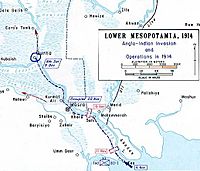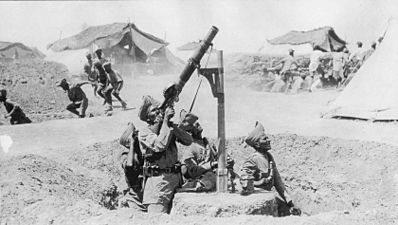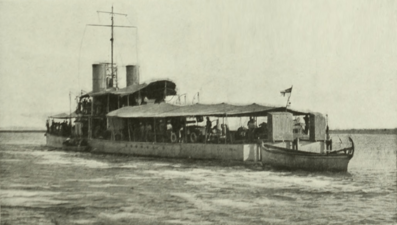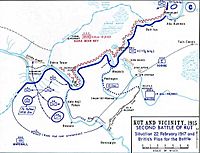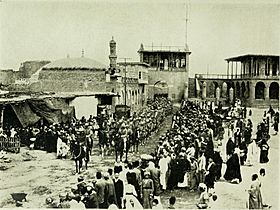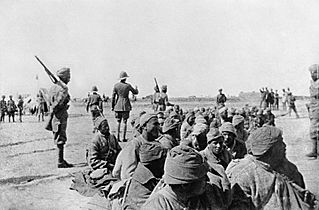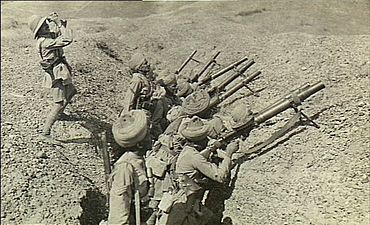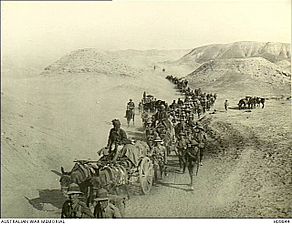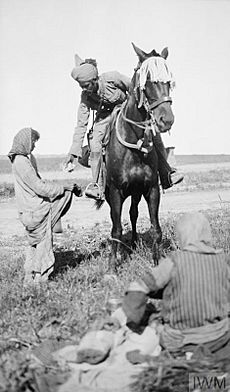Mesopotamian campaign facts for kids
Quick facts for kids Mesopotamian campaign |
|||||||||
|---|---|---|---|---|---|---|---|---|---|
| Part of the Middle Eastern theatre of World War I | |||||||||
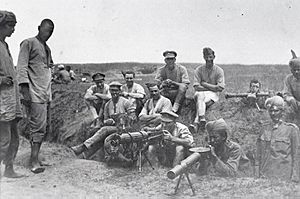 British and Indian machine gunners, Mesopotamia, 1917. |
|||||||||
|
|||||||||
| Belligerents | |||||||||
|
|
Jam'iya al-Nahda al-Islamiya (1918) |
||||||||
| Commanders and leaders | |||||||||
|
|
||||||||
| Strength | |||||||||
|
889,702 (total)
|
c. 450,000 | ||||||||
| Casualties and losses | |||||||||
|
85,200 battle casualties
16,712 died of disease Total: 256,000 casualties |
~89,500 battle casualties
Total: 125,000 casualties |
||||||||
The Mesopotamian campaign was a series of battles fought during World War I in a region called Mesopotamia, which is now modern-day Iraq. It was part of the larger Middle Eastern theatre of World War I. The main groups fighting were the Allied Powers, mostly the British Empire (including troops from Britain, Australia, and a large number from India), against the Central Powers, mainly the Ottoman Empire.
Contents
Why the Fight Started
Ottoman Control and British Interests
The Ottoman Empire had ruled Mesopotamia since the 1500s, but they didn't have full control everywhere. Local rulers often managed areas for them. By the 1800s, the Ottomans started making changes, like building the Baghdad Railway. This railway made travel from Istanbul to Baghdad much faster.
Meanwhile, the Anglo-Persian Oil Company (APOC) had special rights to oil in Persia. In 1914, just before the war, the British government made a deal with APOC to get oil for their navy. This shows how important oil was to Britain.
The Land and Early Plans
The fighting in Mesopotamia happened in the areas around the Euphrates and Tigris Rivers. Moving soldiers and supplies was very hard because of the many swamps and deserts.
When World War I began, Britain quickly sent soldiers to protect their oil refinery in Abadan. They planned to land troops in the Shatt-al-Arab waterway. The 6th (Poona) Division from the British Indian Army was given this job. It was called the Indian Expeditionary Force D (IEFD).
Besides oil, Britain also wanted to keep its strong image, especially among the Muslim people in India. At first, the war plans were mostly handled by India's government, with little help from Britain's main War Office.
Ottoman Preparations
The Ottoman Fourth Army was in the region, but it wasn't very strong. When the Ottoman Empire joined the war in November 1914, their main focus was fighting Russia in the Caucasus Campaign. They moved many of their best troops and commanders away from Mesopotamia.
This left Mesopotamia as a low-priority area for the Ottomans. They didn't expect much fighting there. Their maps of the region were even poor! Lieutenant Colonel Süleyman Askerî Bey became the commander, and he placed some troops near the Shatt-al-Arab and others in Basra.
Key Events of the Campaign
1914: The British Arrive
The British started their attack on November 6, 1914. Their ships fired on an old fort at Fao. The British Indian Expeditionary Force D quickly took over the fort. By mid-November, their soldiers were fully ashore and moving towards Basra.
The ruler of Kuwait, Sheikh Mubarak Al-Sabah, also helped the Allies. He sent his forces to attack Ottoman troops in several places. In return, Britain said Kuwait was an "independent government under British protection." Mubarak even changed the Kuwaiti flag to remove the Ottoman symbol.
On November 22, the British took over Basra after a short fight. The Ottoman troops left the city and moved up the river. The British kept advancing and captured more Ottoman soldiers at the Battle of Qurna. This gave Britain a strong position, protecting Basra and the oil fields. The main Ottoman army was far away, near Baghdad, and didn't try hard to push the British out.
1915: Ottoman Counterattacks and British Push to Baghdad
- Operations of 1915
In January 1915, Süleyman Askerî Bey took command for the Ottomans. He tried to get local Arab leaders to join him against the British. He really wanted to take back the Shatt-al-Arab area.
On April 12, Süleyman Askerî attacked the British camp at Shaiba. This was the Battle of Shaiba. He had about 4,000 regular soldiers and 14,000 Arab fighters. The Arab fighters weren't very effective, but the Ottoman soldiers fought hard. The British fought back and pushed the Ottomans away. Süleyman Askerî was wounded and later died. Colonel Nureddin took his place.
Because of their unexpected success, the British decided to push further. General Sir John Nixon took command and ordered General Charles Vere Ferrers Townshend to advance towards Kut or even Baghdad. Townshend's small army moved up the Tigris River, winning battles along the way. In July, British forces captured Nasiriyah, a big Ottoman supply base.
By late September, British politicians wanted to push for Baghdad, even though it was hard to supply troops so far from their bases. The Ottoman leader, Enver Pasha, realized he had underestimated the importance of Mesopotamia. He created the Sixth Army and put a 72-year-old German general, Colmar von der Goltz, in charge.
On November 22, Townshend and Nureddin fought the Battle of Ctesiphon, near Baghdad. It was a tough fight, and both sides ended up retreating. Townshend decided to pull his troops back to Kut-al-Amara. Nureddin followed him and surrounded the British at Kut.
1916: The Siege of Kut
On December 7, the siege of Kut began. The British forces were trapped and couldn't get supplies easily. General von der Goltz helped the Ottomans build strong defenses around Kut. The British tried three times to break the siege, but they failed each time.
In January 1916, Halil Kut (Khalil Pasha) replaced Nureddin Pasha as the Ottoman commander. The new British commander, General Lake, also took over from General Nixon. British troops inside Kut received some supplies by air, but it wasn't enough.
Between January and March 1916, both sides fought hard battles like the Battle of Sheikh Sa'ad and the Battle of Hanna as the British tried to rescue the trapped soldiers. These attempts failed, and both sides lost many soldiers. Food and hope ran out for the British in Kut. Diseases spread quickly.
On April 19, General von der Goltz died of cholera. On April 24, a last attempt to bring supplies by boat failed. With no way to get food, General Townshend surrendered on April 29, 1916. Over 13,000 British soldiers became prisoners of the Ottomans.
This was a huge defeat for the British, especially after their loss at Battle of Gallipoli just a few months earlier. Many British commanders were removed from their positions.
British Improvements and New Offensive
After the defeat at Kut, the British worked hard to improve their ability to move soldiers and supplies. They made the port at Basra much better so ships could unload quickly. They built good roads and set up rest camps and supply depots. More and better riverboats were used to move supplies upriver. New hospitals were also built. These improvements allowed the British to bring more troops and equipment to the front and keep them supplied.
The new British commander, General Maude, was given more soldiers and equipment. He spent six months training his army. At the same time, the Ottoman Sixth Army was getting weaker.
-
Indian anti-aircraft machine gunners in action during the Battle of Sheikh Sa'ad
-
British gun boat on the Tigris
1917: Taking Baghdad
General Maude launched his new attack on December 13, 1916. The British moved up both sides of the Tigris River, pushing the Ottoman army out of their strong positions. Maude's attack was careful and successful. Khalil Pasha tried to stop Maude near Kut, but Maude cleverly moved his attack to the other side of the river, going around most of the Ottoman forces. The British took Kut again and kept moving up the Tigris.
By early March, the British were near Baghdad. Khalil Pasha tried to stop them at the Diyala River, but General Maude outsmarted the Ottomans. On March 11, 1917, the British entered Baghdad. Many Ottoman soldiers (about 15,000) were captured. A week later, General Maude issued a famous statement saying that the British came as "liberators," not conquerors.
Khalil Pasha moved his weakened Sixth Army upriver to Mosul. General Maude stopped his advance because his supply lines were too long, and the summer heat made fighting difficult.
General Maude died of cholera on November 18 and was replaced by General William Marshall.
1918: The Final Push
The British started their attack again in late February 1918, capturing Hīt and Khan al Baghdadi in March, and Kifri in April. In March 1918, Britain also faced a local uprising in Najaf and had to lay siege to the city until May. For the rest of 1918, the British had to send some troops to help in the Sinai and Palestine Campaign.
As October arrived, talks began to end the war between the Allies and the Ottoman Empire. General Marshall, following orders to gain as much ground as possible before the war ended, launched a final attack. On October 23, 1918, a British force moved quickly from Baghdad. They reached the Little Zab River and fought the Ottoman Sixth Army in the Battle of Sharqat, capturing most of their soldiers.
-
Indian troops prepare to fire against enemy aircraft with Lewis guns.
End of the Campaign
Armistice of Mudros
On October 30, 1918, the Armistice of Mudros was signed, which was an agreement to stop fighting. General Marshall accepted the surrender of Khalil Pasha and the Ottoman 6th Army on the same day. However, British troops kept advancing on Mosul even after the armistice, entering the city on November 14, 1918. This caused problems later because the ownership of Mosul Province and its oil fields became a big international issue.
The war in Mesopotamia officially ended on November 14, 1918.
- Commanders
What Happened Next
After the Ottomans were defeated, the British brought in officials from India to help run the new government. Many Arabs had hoped that defeating the Ottomans would lead to their own independence. Instead, they were disappointed when the British set up the British Mandate of Mesopotamia, which meant Britain would control the region.
This led to new secret groups forming in 1918 and 1919, like the League of the Islamic Awakening and the Muslim National League. These groups wanted to organize people to resist British rule. In February 1919, different groups in Baghdad formed the Guardians of Independence.
The British were worried about controlling Mosul, especially because of its oil. Even though a British official tried to say there was no oil there, it was clear that Britain wanted the oil, and Mosul was key to that. The Iraqi revolt against the British happened in 1920, but the British put it down.
Casualties and Impact
Soldiers Lost
The British Empire forces had about 85,197 battle casualties in Mesopotamia. Many more soldiers (over 820,000) were hospitalized for non-battle reasons, mostly sickness. Of those, 16,712 died from disease. The total British military deaths in this campaign were 38,842, with most of these deaths (28,578) being from sickness rather than battle.
The conditions in Mesopotamia were very difficult. It was unhygienic, extremely hot in summer, and very cold in winter. The land was either sandy desert or swamps, and there wasn't much development, so injured or sick soldiers had to travel long distances for medical help.
The Ottoman forces also suffered greatly, with about 325,000 casualties in total. Deaths from disease were very high for them too. About 13,069 Ottoman soldiers were killed in battle, and many more were wounded or captured.
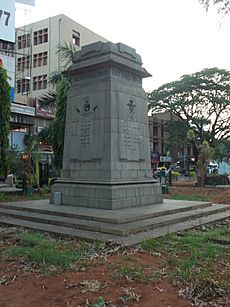
Major Battles of the Campaign
Images for kids


